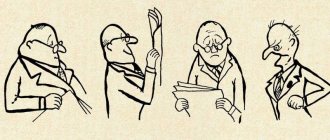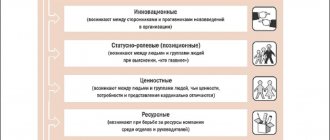Author: ViktorAnikin
30 October 2021 02:03
Tags: Manipulators, how to recognize roles
3086
11
A person is not born a Manipulator. He develops the ability to manipulate other people in order to avoid trouble and achieve what he wants, and he develops this ability unconsciously.
0
See all photos in the gallery
The modern Manipulator, Sjostrom believes, has evolved from a market orientation, when a person is a thing that you need to know a lot about and which you need to be able to manage. Hiding your true emotions is the lot of the Manipulator. The Manipulator sees his main task as making some “proper impression.” Here, for example, is the reaction of a Manipulator who failed to advance in his career or receive a salary increase that was so dear to his heart. Arriving home, he manages to shift half the blame onto his long-dead parent, who tyrannized him, onto his wife, who poorly prepared his breakfast that morning, or onto someone else. He can get drunk or get sick, turn into an obsequious pester, become gloomy, continue a passive strike against himself, humanity, his stupid boss. He can even slam the door and leave the game, leaving his place for a friend. Along with the need to control, the Manipulator feels the need for guidance from above. Manipulation is not a necessary attitude towards life and does not bring any real benefit. Too often, the Manipulator uses psychological concepts as rationalizations for his dysfunctional behavior, justifying his current unhappiness by citing past experiences and past failures. A manipulator is a person who has embarked on a path of self-destruction, who uses or controls himself and other people as “things.” Since the Manipulator lives in each of us to some extent, let's see if we can't highlight it more clearly. There are several main types of Manipulator.
Stuck
0
It is the polar opposite of a calculator. He exaggerates his dependence and helplessness. This person longs to be led, fooled, and the object of concern for others. She lets others do her work for her. Varieties: parasite, whiner, eternal child, hypochondriac, dependent, helpless.
Who is a manipulator
Psychology gives the following definition: a manipulator is a person who seeks to change the behavior and consciousness of others in his own interests, using hidden, sometimes violent tactics. They are also called emotional-energy vampires, psychopaths, perverted narcissists. Let's look at a couple of examples.
A positive manipulator is a mother who wants to succeed as a parent and boast about her son’s successes at school, forcing him to study. She can use threats for this (swearing, raising her voice), blackmail (you won’t sit at the computer until you do your homework) and even assault (a belt is still an acceptable punishment in some families). The methods she uses are condemned in pedagogy, but initially she is guided by good goals.
A negative manipulator is a shopaholic wife whose goal is to extract as much money as possible from her husband for a new purchase. Her methods: hysterics, blackmail (if there is no fur coat, there will be no sex / I will divorce / I will take the children), flattery. Such women ruin a man financially and exhaust him mentally.
But the most terrible manipulators, which are found all the time, pursue only one goal - to assert themselves at the expense of a loved one. They cling to him like parasites, drain him morally to the very bottom, and then disappear in order to find a new victim. Therefore, it is so important to recognize such people in your environment and be able to repel them.
Defender
0
The opposite of Judge. He overemphasizes his support and tolerance for mistakes. He spoils others by sympathizing with them beyond all measure and not allowing his clients to get on their feet and grow on their own. Instead of minding his own business, he is ready to take care of the needs of others. Options for the Protector: mother hen, comforter, patron, student, helper, selfless.
Typology of manipulative character types by E. Shostrom
E. Shostrom, in his book “Anti-Carnegie or the Manipulator,” described what constitutes a type of social character called a “manipulator.”
He needs to control the situation at all costs: he is able to impose his will in everything, tries to manipulate any phrase, any situation.
A person is not born a Manipulator. He develops the ability to manipulate other people in order to avoid trouble and achieve what he wants, and he develops this ability unconsciously.
The modern Manipulator, Sjostrom believes, has developed from a market orientation, when a person is a thing that you need to know a lot about and which you need to be able to manage.
Hiding your true emotions is the lot of the Manipulator. The Manipulator sees his main task as making some “proper impression.”
Manipulation is not a necessary attitude towards life and does not bring any real benefit. Too often, the Manipulator uses psychological concepts as rationalizations for his dysfunctional behavior, justifying his current unhappiness by citing past experiences and past failures.
A manipulator is a person who has embarked on a path of self-destruction, who uses or controls himself and other people as “things.” The manipulator lives to some extent in every person. There are several main types of Manipulator.
1. Dictator.
Exaggerates his strength.
He dominates, orders, quotes authority and does everything to control his victims. Types of dictator: Abbess, Superior, Chief, Boss, junior Bosses.
2. Rag
(weakling) – usually a victim of a dictator, the polar opposite.
The Rag develops great skill in interacting with the dictator. He exaggerates his sensitivity, he forgets, he does not hear, he is passively silent. Varieties of Rags: Suspicious, Stupid, “Chameleon”, Conformist, Shy, Yielding.
3. Calculator
exaggerates his control.
He deceives, exaggerates, lies, tries to outwit and deceive other people. Variations of the Calculator: Businessman, Fraudster, Gambler, Advertising Creator, Blackmailer, Calculating everything in advance.
4. Stuck.
It is the polar opposite of the Calculator.
He exaggerates his addiction. This is a person who longs to be led, fooled, and cared for. He lets others do the work for him. Varieties: Parasite, Whiner, Eternal Child, Hypochondriac, Dependent, Helpless.
5. Bully
.
Exaggerates his aggressiveness, cruelty, and hostility. He: Abuser, Hater, Gangster, Menace.
Female variation -
Grumpy woman.
6. Nice guy.
He exaggerates his caring, love, kills with his kindness.
In some ways, confronting him is more harmful than confronting a Bully. The nice guy almost always wins. Varieties: Obsequious, Benevolent, Moralist, Organizational Man.
7. Judge.
Exaggerates his criticism.
He doesn’t trust anyone, is full of accusations, indignation, and has difficulty forgiving. Varieties: Omniscient, Accuser, Gatherer of Evidence, Bailiff, Shamener, Evaluator, Avenger, Forcer to Confess Guilt.
8. Defender.
The opposite of Judge.
He overemphasizes his support and tolerance for mistakes. He spoils others by sympathizing with them beyond all measure and not allowing his clients to get on their feet and grow on their own. Instead of minding his own business, he is ready to take care of the needs of others. Protector options: Mother Hen, Comforter, Patron, Disciple, Helper, Selfless.
In the Manipulator, one of these types or their combinations are hypertrophied. If a person is one of the types of Manipulator to the most pronounced degree, he projects its opposite onto the people around him and makes them his goals. For example, a Rag wife often chooses a Dictator husband and then controls him using all sorts of “subversive” methods.
Manipulation is a lifestyle, it is a life scenario that regulates the entire system of interaction with the world, aimed at controlling both oneself and others.
27)
The Heymans-Le Senne typology is the most practical and applied. Whatever field of activity we choose, we can find practical application in any of them. It works well in professional activities in the selection of employees and in consulting work, and also explains many issues and problems in family relationships and in family conflicts. This typology is indispensable in everyday life, especially since it is quite simple and understandable. But at the same time, this typology well explains the variety of types of human behavior. For those unfamiliar with psychology and non-professionals, it is convenient because it does not have a large theoretical basis, to understand which you need to read more than one volume of theoretical works. It is built on only three components, which are completely understandable to everyone, and 8 character types are well remembered.
Three components —
emotionality, activity and primacy-secondaryness are taken as the basis for the typology of characters. Based on these three components and their various combinations, Le Senna and Heymans received eight types of characters: 1) stormy, active; 2) passionate; 3) sanguine; 4) phlegmatic; 5) nervous; 6) sentimental; 7) amorphous-carefree ;8) apathetic. Before we begin to consider these eight character types, let us dwell on the meaning and description of the components themselves. Emotionality is how strongly a person reacts to external circumstances, that is, how easily he has an emotional reaction. For example, it is very easy to offend someone with one careless word, while for others even strong indignation does not cause an emotional reaction; some flare up like fire, others react to the same thing quite calmly. If a person has a strong emotionality, then we will designate this as E+, if a person has a weak emotional reaction, then E –. The second component is activity. Activity is an internal need for action or inaction (or for thinking about actions). Some people cannot spend a minute without action, they constantly need to do something, go somewhere, they must be constantly busy with something. Others, on the contrary, are constantly thinking about their actions. They think more than they do, they dream more than they act. If the former are depressed by the state of idleness, then for the latter it is a normal state from which they emerge without enthusiasm. If a person is active, then we will designate him as A+, and vice versa, inactive, as A –. The third component of this typology is the secondary and primacy of nature. Let us denote them with the first letters: B and P. These natures differ from each other in how long and strong the impressions, be they from the external or internal world, remain and continue to hold this personality captive. If a person has secondary traits, then, This means that this person works like a battery or accumulator, that is, he is more “charged” by impressions, they seem to accumulate inside. For example, he does not quickly forget grievances, is under the impression of an emotional experience for a long time, and does not immediately move away from arguments. His mood is even and calm. He rarely gets angry and is rarely seen in a depressed mood. But when he is “discharged,” his anger is powerful, like a “short circuit.” He is faithful to his habits and affections and rarely changes them. It is difficult to switch from one subject to another or from one task to another. If a person has traits of primacy, then this person, unlike what we considered above, does not remain impressed for long. They bounce off it as quickly as a ping-pong ball. If the actions of any factors are taken to be the blow of a tennis ball, then the blow, the response-reaction, seems to return immediately. Such a person easily adapts to reality, quickly changes his priorities, is easy-going, does not get lost in the face of surprises, and loves short activities. So, based on three components, Heymans and Le Senna identified eight characters. Human adaptability Adaptability is the level of actual adaptation of a person, the level of his social status and sense of self - satisfaction or dissatisfaction with himself and his life. A person can be harmonious and adapted or disharmonious and maladapted. Maladaptation is always psychosomatic (both soul and body) and occurs in three forms: neurotic (neuroses), aggressive-protest and capitulative-depressive (psychosomatic diseases and behavioral disorders). A person’s adaptability is ensured by evolutionarily selected ones that are appropriate for his nature. The first component of human nature that ensures adaptability is instincts. According to the concept of V.I. Garbuzov, seven instincts can be distinguished: self-preservation, procreation, altruistic, exploration, dominance, freedom and preservation of dignity.
28)
Adaptation is the level of actual adaptation of a person, the level of his social status and sense of self - satisfaction or dissatisfaction with himself and his life. A person can be harmonious and adapted or disharmonious and maladapted. Maladjustment is always psychosomatic (of both soul and body) and occurs in three forms: neurotic (neuroses), aggressive-protest and capitulative-depressive (psychosomatic diseases and behavioral disorders). Human adaptability is ensured by evolutionarily selected elements that are appropriate for his nature. The first component of human nature that ensures adaptability is instincts. According to the concept of V.I. Garbuzov, seven instincts can be distinguished: self-preservation, procreation, altruistic, exploration, dominance, freedom and preservation of dignity. Depending on the dominance of one or another instinct, the primary fundamental typology of individuality follows. And each person belongs to one of seven types: I – “egophilic”, II – “genophilic” (Latin genus – “genus”), III – “altruistic”, IV – “research”, V – “dominant”, VI – “libertophilic” (Latin libertas – “freedom”), VII – “dignitophilic” (Latin dignitas – “dignity”). Let us present brief personal characteristics within the framework of the above typology. I. egophilic type. From early childhood, a person of this type shows a tendency towards increased caution, the child does not let his mother leave his side even for a moment, is afraid of the dark, heights, water, etc., intolerant of pain; on the basis of this type, a personality is formed with pronounced egocentricity, anxious suspiciousness, and a tendency under unfavorable circumstances to obsessive fears, phobias or hysterical reactions. II. genophilic type. It is characterized by a peculiar kind of ego that is replaced by the concept of “We” (by “We” we mean family) up to the denial of “I”. Values, goals, life plans are subordinated to one thing - the interests of children, family. The evolutionary expediency of having this type lies in the fact that its carriers are the guardians of the family, the guardians of the gene pool of the clan, and the guardians of life. III. altruistic type. People of this type are characterized by kindness, empathy, care for loved ones, especially the elderly, and the ability to give the last to others, even what they need themselves. They are convinced that it cannot be good for everyone if it is bad for someone alone. IV. research type. From early childhood, people of this type are characterized by curiosity, a desire to get to the essence of everything, and a penchant for creativity. At first, these people are interested in everything, but then they become more and more captivated by one passion. Travelers, inventors, scientists are people of this type. V. dominant type. From early childhood, there is a desire for leadership, the ability to organize a game, set a goal, show the will to achieve it, a personality is formed who knows what she wants and how to achieve what she wants, is persistent in achieving the goal, ready to take calculated risks, able to understand people and stories them behind you. VI. libertrophilic type. Already in the cradle, a child of this type protests when he is swaddled. The tendency to protest against any restriction of his freedom grows with him. People of this type are characterized by a desire for independence, denial of authority (parents, teachers), tolerance to pain, a tendency to leave their father's home early, a predisposition to risk, stubbornness, negativism, intolerance to routine, and bureaucracy. VII. Dignitaphilic type. Already in early childhood, a person of this type is able to grasp irony, ridicule and is absolutely intolerant of any form of humiliation. Characterized by recklessness, readiness to sacrifice everything in defending one’s rights, and an unshakable position “Honor is above all.” The self-preservation instinct of such a person is in last place. In the name of honor and dignity, these people go to Calvary without hesitation.
29)
Compatibility of people and typology Several levels can be distinguished in the compatibility of people.1.
The highest and most complex is value-orientation unity: the compatibility of life values, aspirations, ideals, interests, beliefs of people (the closer they are, the easier it is to understand each other and the stronger the compatibility).2. Coherence of a person’s functional-role ideas in a friendly, family, or labor union. For example, if family members have different understandings of their roles and present expectations and corresponding demands that are rejected by others, there will not be the necessary compatibility in the family, but many conflicts will arise. Here, a role is understood as a relatively stable pattern of behavior developed in a given society to implement a certain social function, i.e. behavior that is expected from a person by other people when performing certain functions (in a specific place, in specific circumstances). Inconsistency of ideas about roles, rights, responsibilities, leisure, distribution of household labor, striking discrepancies in everyday habits, etc. can seriously disrupt relationships between people and lead to incompatibility.3. Compatibility of individual psychological characteristics:❖ psychophysical compatibility of temperaments;❖ compatibility of innate qualities of psychosociotypes;❖ compatibility of acquired character qualities; sexual compatibility (it plays an important role in family relationships). In general, the following are necessary: 1. The ability to be critical of oneself.2. Tolerance of others.3. Trust in others. If these qualities are absent, a person cannot get along with other people. To achieve compatibility in small groups when they find themselves in isolation for a long time (polar expedition, crew of a spaceship or submarine), additional factors are required:1 . The maximum possible workload of people with purposeful activities.2. Accuracy in determining the task at hand and the period of coexistence.3. The possibility of privacy for each of the participants. Psychological selection of people according to their level of compatibility is always desirable. Depending on the level of activity/passivity and focus on external circumstances/personal experiences, American psychologists R. Ackoff and F. Emery identify different personality types and predict the degree of psychological compatibility (Fig. 6.12). OA and LP are coordinates for pure types
(person or reacts quickly and actively to external circumstances, without thinking about himself - type OA; or, conversely, is always busy with himself and tries not to be active - LP). The space of OP and LA is for mixed types (a person simultaneously monitors both circumstances and processes in his inner world).
Rice. 6.12. Typology of R. Ackoff, F. Emery
The combination of types gives 10 combinations: OP-LA, LP-OA, OA-LA, OP-LP, OP-OA, LP-LA, LA-LA, OP-OP, LP-LP, OA-OA.
Let us consider the unique behavior of people who make up such couples (for example, married ones) in conflict situations. 1. OP-LA.
If a conflict arises, people of each of the two types believe that it occurred through the fault of the LA (such a person actively realizes only his desires, and is often selfish).
However, paradoxically, both are trying to change the behavior of only the OP, who is influenced without resistance, compliant, as a result of which the conflict is easily extinguished. When a couple has friction with others, it is the OP who perceives the situation more sharply, but due to his passivity, he himself does nothing, but only reports the situation to the LA, after which he actually influences the situation in favor of the couple. Consequently, they do not compete with each other, but cooperate both psychologically and behaviorally.2. LP-OA.
In case of conflict, both of these types believe that the LP is to blame.
But due to his nature, the LP is not too susceptible to the effects of OA for his behavior to change. It is adjusted only after the PL gives an internal assessment of the need for such changes. OA is satisfied with the development of the situation, and the conflict subsides. In the event of a conflict with others, the PL hides behind the OA, allowing him to independently resolve the problems that have arisen and agreeing with his decision. This pair of people is stable and has a clear leader - OA.3. OA-LA.
Both people are sure that the aircraft is to blame for the conflict.
However, everyone tries to change not themselves, but their partner. Only the OA is capable of responding to such efforts (it is sensitive to external influences), but since it has an active character, it does not want to be influenced and does not respond to the actions of the aircraft. As a result, the conflict flares up, with OA playing a more active role in it. In relationships with others, both strive to influence the outside world (neighbors, colleagues, relatives, children) and conflict with each other over the management of this influence. The couple finds it difficult to get along with the people around them and is quite conflictual in their internal relationships.4. OP-LP.
In the opinion of both, the LP is to blame for all the problems, although each seeks to change only himself.
The OP believes that he is constantly sacrificing himself for the sake of a peaceful relationship, but the LP does not see these sacrifices and does not show whether he appreciates the OP’s self-sacrifice. This does not contribute to the stability of the couple. This couple is most often unable to change the environment in order to reduce the severity of external and internal problems. She is perceived as a passive, inactive couple, dissatisfied with each other.5. OP-OA.
Everyone understands well that the conflict that arises between them affects the behavior of their partner.
However, OP is trying to change herself, and OA is only trying to change the other side. Because she is susceptible to outside influence, she responds to the OA's demands and peace is restored. At the same time, the establishment of harmonious relationships of such a couple with other people is hampered by the fact that the OP and OA see the problems that arise with others differently. In addition, they unwittingly transfer the conflict into the sphere of their interpersonal relationships. In order to maintain stability, they need (and they try to do this) to reveal to each other their views on the environment and their relationships as little as possible, because almost any statement leads to a quarrel. In the eyes of others, this is a couple in which one of its participants is under the “shoe.”6. LP-LA.
Each of them is very indifferent to the actions of their partner and responds poorly to them.
At the same time, the LA is trying to use the second side for its own purposes, but since it is very insensitive to such influence, these attempts fail. Over time, the LA's desire to influence the situation wanes, and the partners move away from each other. They are inactive in relationships with others, as they are busy with their own problems. From the outside they seem peaceful, although rather indifferent to their partner. Under unfavorable circumstances, this indifference can provide the couple with a certain stability.7. LA LA.
In case of conflict, everyone considers the problem from the point of view of how it can affect their personality, without taking into account the partner’s reaction, and seeks to influence the other in order to achieve their goals.
Both, however, do not succumb to such influence, do not react to it, and therefore conflict a lot without apparent success. Both are unaware of their impact on others, nor of how external circumstances affect the couple’s relationship. At the same time, both are trying to change other people, but they are making efforts separately, trying to turn things in their favor. From the outside they look like an aggressive, conflicting (quarrelsome) couple who do not understand what the world around them is like and what is happening in it.8. OP-OP.
According to each partner, the cause of the conflict lies in the actions of the other.
At the same time, both strive to avoid collisions, which stabilizes the couple as a whole. They see external circumstances in the same way, but everyone is either passive or trying to solve problems on their own. They do not try to change the environment through joint efforts. Outwardly, they are a peaceful, passive, partly friendly and compliant couple, although uncommunicative.9. LP-LP.
Each does not respond too much to the actions of the other, so they do not conflict, but they do not interact either.
Without pestering himself, he is glad that he is not offended either. The conflict that arises fades away very quickly, since no one is throwing wood on the fire. The couple does not communicate, and therefore does not conflict with other people. When external circumstances change, everyone tries to independently adapt to the changes. To those around them, this couple does not seem very interesting, although they are peaceful.10. OA-OA.
“The other is to blame for everything” - this is the point of view shared by this couple, therefore each partner considers it his duty to try to change the behavior of the other, but the other does not respond to his efforts. Everyone thinks that the other side does not understand him, and he tries to prove that he is right. The conflict over this does not go away for a long time. To achieve peace, both can try to change the environment, but even in this case they will compete with each other. Having started a conflict with people, they certainly argue with each other. Those around them perceive this couple as quarrelsome and hostile. Its stability is minimal. Numerous studies on the compatibility of people have made it possible to formulate its main law: the innate qualities of partners should be contrasting, while the acquired qualities should be similar. The union of spouses who are not too different in their origin, living conditions, and upbringing is more durable because in this case, the likelihood that attitudes, values, interests, ideals, habits (i.e., acquired qualities) will coincide is obviously higher.
30) Motivation
(from lat.
movere
) - incentive to action; a dynamic psychophysiological process that controls human behavior, determining its direction, organization, activity and stability; a person's ability to actively satisfy their needs.
Extrinsic motivation
(extreme) - motivation that is not related to the content of a certain activity, but is conditioned by circumstances external to the subject.
Internal motivation
(intrinsic) is motivation associated not with external circumstances, but with the very content of the activity.
Positive and negative motivation
.
Motivation based on positive incentives is called positive. Motivation based on negative incentives is called negative. Example: the construction “if I clean up the table, I will get candy” or “if I don’t play around, I will get candy” is a positive motivation. The construction “if I clean up the table, then I won’t be punished” or “if I don’t play around, then I won’t be punished” is a negative motivation. Sustainable and unstable motivation
.
Motivation is considered sustainable if it is based on a person’s needs, since it does not require additional reinforcement. There are two main types of motivation: “from” and “to”, or the “carrot and stick method”. Also distinguished: individual motivations aimed at maintaining homeostasis, hunger, thirst, avoiding pain, striving for temperature optimum; group, caring for offspring, finding a place; in a group: hierarchy, maintaining the community structure inherent in a given type, cognitive: investigative behavior, play activity
Why do people become manipulators?
In psychology there is no consensus on this matter: researchers name different reasons, and they all have a place to be, because each individual case is unique.
Reason 1. Mistrust
This refers to distrust of yourself and everyone else. The manipulator is in constant conflict with himself, because he does not know what to expect from himself in the next minute. He transfers suspicions to others. As soon as a person important to him appears in his circle, his influence seems to tie him to himself, not giving him freedom. Full control provides him with at least some temporary peace of mind. This is Frederick Perls's point of view.
Reason 2. Power
The manipulator wants to gain unlimited power over others: it doesn’t matter whether it’s one person or a whole crowd. Through his actions, he forces them to do, feel and think only what HE wants and can control. This is Erich Fromm's point of view.
Reason 3. Powerlessness
A passive manipulator, admitting his own powerlessness, evokes pity for himself, and people, due to their gentle nature, fulfill his wishes. An active person, on the contrary, uses the helplessness of others in order to subjugate them to his will.
Reason 4. Approval of others
For this reason, a person with low self-esteem becomes a manipulator. His task is to gain the approval of everyone around him. Moreover, he often hates them, but he always smiles flatteringly, gives gifts, says compliments and by hook or by crook pretends to be the sweetest person. Ellis's point of view.
Reason 5. Fear of difficulties
There are people who are afraid to make responsible decisions and change their own lives. Their task is to avoid them, and this can be done through someone who is nearby and can provide them with the necessary comfort. Burn's point of view.
Among other reasons, psychologists identify:
- market relations, when a person must manipulate others in order to save his business and remain competitive;
- family relationships that the manipulator saw in childhood, for example, when the father forced the mother to fulfill his every whim;
- the desire to play with the feelings of others, to make sure of one’s own worth.
In fact, psychological manipulation is a complex mechanism that most often cannot be explained by a single cause. They all go in one ball, sometimes turning a person into a real monster.
An example from life. One of the schools was reputed to be the best in the city: competent teachers, excellent education, high percentage of admission to universities. Everything was fine until the head teacher ended up in a psychiatric clinic. The conduct of her case revealed the reason for the school’s success: its director manipulated his deputy for 5 years. She was initially passive, driven and controlled (+ single mother), which he took advantage of: he put pressure on her through blackmail (I would fire her, deprive her of her salary and bonus, ruin her work record, expel her son). As it turned out, she did all the work at school both for him and for herself, and was convinced that everything she had achieved over the years was his merit.
The woman had to undergo a long rehabilitation course. Both psychologically, in order to get rid of the influence, and physically, since all these 5 years she worked without vacation and practically without days off, bringing herself to exhaustion and exhaustion.
The director also failed to avoid forced observation by psychologists. It was found that he did this for several reasons: comfort at the expense of another, submission of the powerless, a great desire to gain the approval of others. And most importantly, a serious personality disorder (hysterical along with passive-aggressive).
Advantages
The obvious advantage of the technology described above is its versatility. A crane and a machine for transportation are convenient and profitable. In addition, CMUs work with different types of cargo, including bulk cargo, containers or pallets, without the use of additional equipment.
The ability to additionally install replaceable equipment on the crane-manipulator installation, for example, a cradle or a bucket for trench work, increases the operating efficiency of the equipment several times.
Installation of a crane-manipulator mechanism is possible on almost all types of freight transport with a chassis suitable for a certain type of work and terrain characteristics. It is enough to select the type of transport taking into account the load capacity and workload of the site in order to use it as economically and safely as possible.
The advantages of the equipment also include weight and dimensions, which are much more compact compared to similar special equipment, affordable tariffs for work, including transportation of goods. An indisputable advantage is the connection of the unit to the vehicle engine and the possibility of remote control.
Suggestion
Passive aggressors love to inspire their victims with something that doesn’t really exist. They lie without a twinge of conscience, they commit inappropriate acts, and then foam at the mouth and deny everything. Their main goal is to make the victim believe that she made it all up.
Not long ago I came across the detective drama “The Girl on the Train” with Emily Blunt in the title role. If you haven't seen this movie, I highly recommend it. The main character's husband is a typical passive aggressor, programming his victim to develop a scenario convenient for himself.
Working body options
Loader cranes always have replaceable equipment in their kits, where each working element is designed for one or another type of work. For example, if these are hydraulic grips, then it is better to use them for piece items or containers.
Bulk materials or small pieces are loaded using grabs, and rolls are lifted and moved with special grips. There is a removable safety cradle for people, and forks for working with pallets. There is also an option for curbstones - load grippers, etc.
Signs
In order to promptly recognize a manipulator in your environment, you need to know his psychological portrait, typical phrases, characteristic gestures and what he looks like (this even affects his appearance).
Signs of a manipulative person:
- speeds up relationships: in a matter of days, instills trust and fills the entire space;
- is satisfied with total control: he chooses films, dishes, hobbies, even his partner’s underwear;
- isolates: narrows the victim’s social circle to 1 person - himself;
- plays: attacks of total control and uncontrollable jealousy are replaced by periods of tenderness and care in order to lull the victim’s vigilance;
- uses: voice, gaze, physical strength, gestures;
- condemns: always makes evil jokes and ridicules;
- cultivates a feeling of guilt, due to which the victim is constantly in a state of stress;
- neglects the victim’s condition: he does not care what she feels and thinks;
- punishes: physically, lack of attention or sex, boycott, silent insult, tears, hysterics;
- keeps him in constant tension: a meaningless little thing can make him angry and provoke a scandal;
- does not enter into open conflicts, preferring that the victim starts a quarrel (he deliberately infuriates her for this).
This is a brief psychological description of the manipulator, which can be supplemented with various details. External signs by which it can be recognized:
- first impression: it seems perfect;
- looks good, well-groomed;
- knows how to speak beautifully, does not skimp on compliments;
- always makes eye contact;
- prefers a classic style of clothing;
- does not stand out from the crowd;
- tries to violate personal space, to conquer it: he touches, touches his shoulder, takes his hand, while he lets him in rather reluctantly.
Typical phrases:
- You are the same as everyone else.
- Don't beat yourself up.
- You got it all wrong.
- I am who I am. I won't change.
- I thought you loved me / ... you trust me / ... we are friends.
- I already apologized - what else do you want from me?
- All problems are because of men (because of women).
- Let's avoid hysterics and drama.
- What will people think of you?
- It's impossible to talk to you.
However, most often the presence of a manipulator in life can be recognized not by his appearance, phrases or psychological portrait, but by the state of the victim. Unfortunately, dictators most often become those close to them, who so capture the will of the other that he cannot see them as an enemy. This could be parents (mom constantly calls and presses for pity that you should definitely come to her and help), older children (they extract money from mom and dad), a friend (regularly asks to do something for him, although he himself does not give anything in return), a loved one (forces you to stay at home because he is jealous of every pillar).
Signs that you have become a victim of a manipulator:
- constant feeling of guilt;
- frequent quarrels;
- fear of angering or offending him;
- state of stress and constant tension;
- break in relationships with once close people, lack of friends;
- lack of initiative, passivity in decision making;
- complete trust only in him;
- lack of career and personal growth;
- he becomes the center of the universe.
And, according to psychologists, victims of manipulators often wear wide dark glasses and walk with their heads down.
Manipulation methods
Manipulative people use different methods to control others.
According to Breaker:
According to Simon:
- aggressive anger;
- declassing;
- selective inattention;
- false guilt, scare tactics;
- lying or deception by omission;
- minimization (denial of one’s own guilt + excuses);
- victim blaming;
- distraction (going away from the topic);
- excuses;
- negation;
- shaming;
- projection of guilt (blaming others);
- rationalization (justification);
- the roles of victim or servant;
- feigning innocence or confusion;
- hidden intimidation, threats;
- seduction
Sarcasm and teasing
Passive-aggressive manipulation is based on sarcastic grins, teasing and caustic remarks towards the partner. This is difficult to discern right away for the simple reason that close people will allow each other to make fun of themselves. But one day, friendly banter can take things to the next level.
Sarcasm is used by the manipulator as a weapon that slowly kills the victim. With each new time, the injections will be more caustic and deeper. A gradual increase in the amount of sprayed poison ensures addiction. And if you get angry at one of the comments, the aggressor can always write it off as a joke. At the end of the conversation, he will add the catchphrase: “You have become too sensitive.”
Russian tour operators: Türkiye will be the leader both in May and this summer
Rospotrebnadzor banned the use of smartphones in education
What hairstyle to do for gray hair: bob and other fashionable options this year
Obstacle to achieving goals
The manipulator constantly comes up with ways to slow down the personal and professional development of the victim. For example, he will blame his wife, who is on maternity leave, for reducing the quality of life of the family, but at the same time he will not want to let her go to work (he will prevent her from moving to a higher-paying position).
This, at first glance, paradoxical picture allows you to keep your other half financially dependent. At the same time, the emotional aggressor will be extremely reluctant to part with his money, and in the end he will completely “cut off the oxygen.”
Production leaders
Models of special equipment from Russian and international brands are presented on the market. Among the Russian representatives, the most famous are ZAO BAKM and ZAO Inman; in addition to them, the brands mentioned above, Palfinger, Amco Veba from Italy, HIAB, the Japanese company UNIC and others supply the market with high-quality equipment.
specializes in the production of high-performance and miniature loader cranes. Production facilities are concentrated in the Moscow region, Balashikha.
JSC "Inman" supplies the market with crane models mainly with a Z-shaped boom mechanism using imported components from leading manufacturers from Europe. To increase the rigidity of the boom equipment, a durable and reliable hexagonal profile is used.
The HIAB brand is a leader in the global market, producing the widest range of units for working in extreme conditions with temperature changes.
The Amco Veba brand focuses on the production of equipment for universal work, with reverse boom equipment and simplified models.
The manufacturer keeps control over the quality and safety level of the equipment, which is recalled in the slogan about maximum safety with the same performance.
The UNIC brand supplies cranes to more than 100 countries around the world. The equipment of the Japanese brand is distinguished by its technological effectiveness and precision of work with the highest possible performance indicators and load capacity, and is definitely not inferior to models of European trends.
Lever control
System management is built on the use of levers, where each has its own function. Separate levers are responsible for moving the boom, installing supports, moving the cable, etc. For convenience, on many models of equipment, the levers are located at the base of the boom equipment on both sides of the CMU.
Options for placing control levers at the top of the boom near the operator's seat are not excluded. Modern models are equipped with control panels for the most convenient and safe work with remote control of equipment.
Technical educational program
The choice of CMU for work on site directly depends on the model, respectively, the set of characteristics responsible for functionality and performance. The main ones worth highlighting are:
- boom extension data;
- load capacity;
- minimum values of rotary R installation;
- number of arrow faces;
- type of boom telescoping, affecting the order of extension of sections.
CMUs based on a vehicle are also evaluated according to the technical characteristics of the latter. Load capacity and support indicators are important. The installation capabilities of the vehicle itself for working with certain types of cargo will depend on them.
Before making a choice, you need to study the full list of technical characteristics and analyze the load-height diagram. It is from this that it will be possible to determine the installation possibilities.
What are they suitable for?
A CMU on a vehicle or a stationary type effectively copes with the task of mechanizing manipulations associated with cargo on the territory, including lifting up or lowering into a hole, trench, well. The convenience of using the installation is explained by the absence of the need to connect additional machines to the process. The crane loads, the vehicle on which it is installed transports. It is convenient and cheaper than other delivery methods.
There are practically no restrictions. Loader cranes deliver almost all types of cargo, including those packaged in containers and stacked on pallets.
Is it possible to use the CMU for transporting non-standard cargo? Quite. The machine, equipped with on-board installation, will cope with long items, metal, machine tools, glass, wood and even construction sheds, as well as passenger cars requiring repair.
In addition, special machines equipped with cranes are suitable for work in the following areas:
- low-rise construction;
- installation and repair of high-rise buildings;
- public utilities;
- in areas with limited conditions for the use of special equipment.
The last point is especially important, given that there may simply be no alternative to a crane.
What is KMU?
Crane manipulator unit (CMU)
is a self-propelled loading and unloading machine mounted on a truck body, with a working section consisting of a rotating cantilever boom. It is used for loading and unloading rolling stock of vehicles, for predominantly heavy and piece goods, as well as for construction and repair work.
As a lift, the CMU consists of:
- arrows,
- gripping devices (usually a hook),
- management,
- frames for support.
Hydraulic manipulators with a hydraulic drive for a load-grabbing device are also classified as hydraulic manipulators. They are mainly used where cargo transshipment is required.
Pneumatic types of CMU:
- columned,
- console,
- semi-pantographs,
- pantographs,
- vacuum lifters.
According to the method of folding the boom, all existing CMUs are divided into the following types of manipulators:
- with telescopic (retractable),
- with L boom,
- with Z boom.











